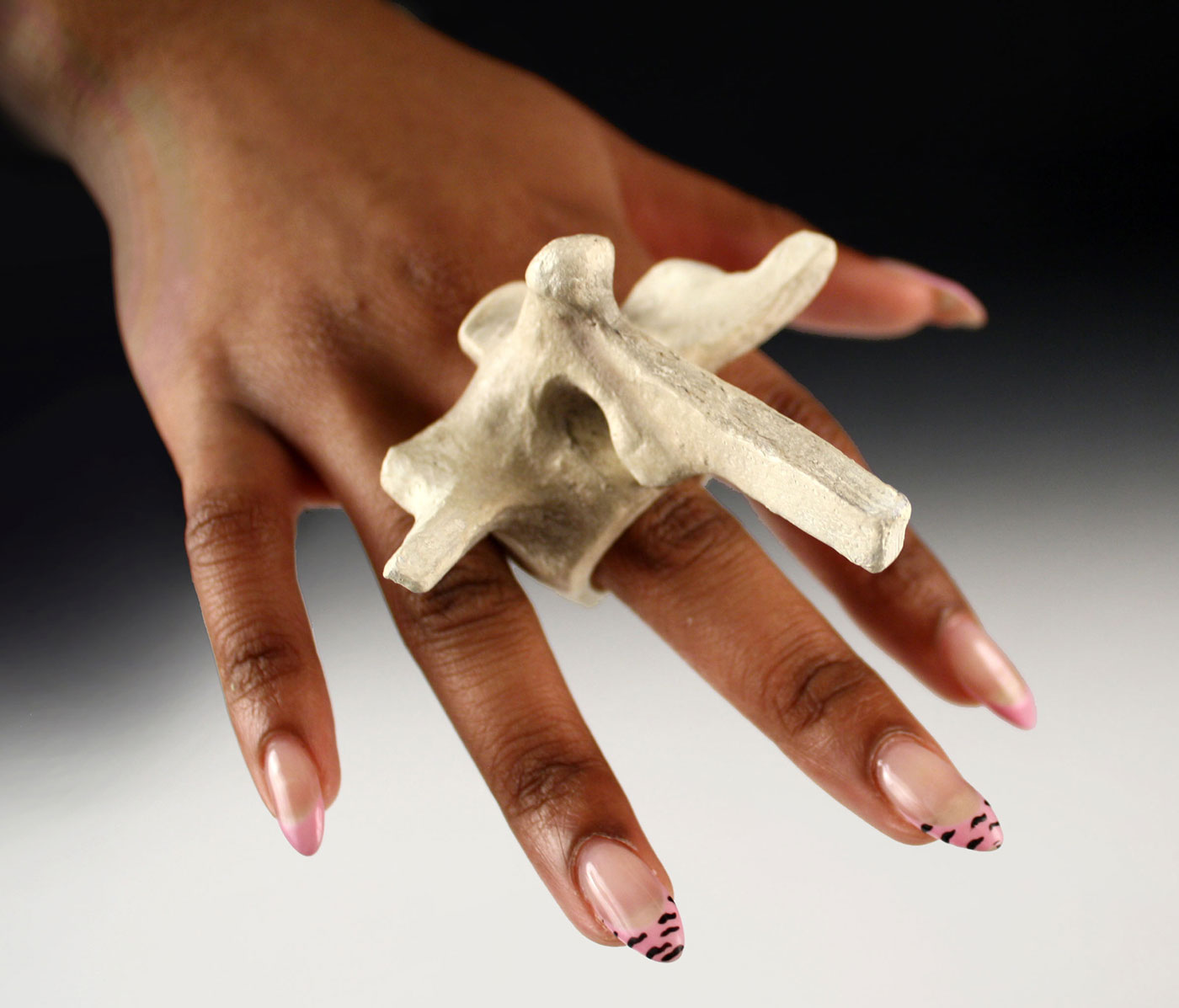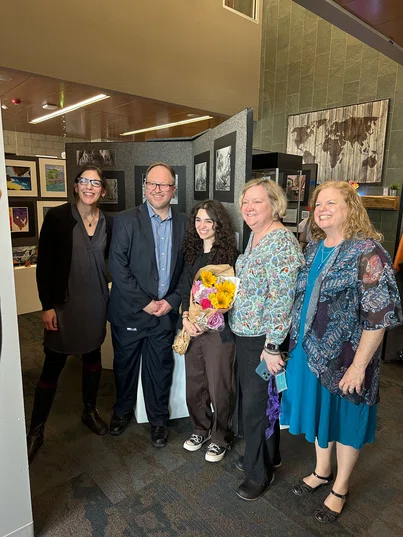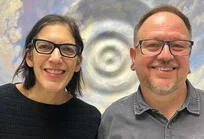

Vertebrae Ring

Height: 3” x Width: 2.75” x Depth: 2.5” | Material(s): Ceramic, charcoal powder | Process(es): A ceramic ring in the shape of a vertebrae, burnished with charcoal powder for shading | Idea(s): I am very intrigued by nature, so I chose to focus on bones and rocks for my sustained investigation inquiry. | Curatorial Note:
Experimentation with a variety of firing techniques was successful. The use of charcoal to emphasize shadows and the use of burnishing creates a successful bone-like surface
Andriana Nicoghosian


AP 3-D
Bloomfield Hills High School
Bloomfield Hills, MI, USA
Student statement
Student statement
What did you do to improve your 2-D, 3-D, or Drawing portfolio skills?
I improved my skills by constantly working and learning through experimentation. I tried many ceramics methods and failed quite a few times before finding the perfect combination. For the piece featured here, I experimented with different finishes. I ended up painting the surface with acrylics and adding dimension through chalk and charcoal burnished into the surface to create an illusion of a more realistic bone shape and contour.
How did your classmates help you in the creative process?
My classmates were always open for critiques and constructive feedback, and I bounced ideas off of them frequently. Many of my classmates were close friends of mine, and it was great to be able to create art with them and have such an open community of talented young artists. We kept each other on track and always offered help to whoever needed it. I will forever value all of the friendships formed in that classroom and will always be grateful for the wonderful experience I had.

I chose to focus on bones and rocks for my sustained investigation inquiry. I show this through exploring various organic shapes and using a neutral color pallet.
Did you participate in art shows at your school or in your community?

I had my artwork shown in multiple local exhibitions, but I am most proud of one that was held at my high school: the Robert C.J. Traub Memorial Scholarship. This was a judged showing of my work that won me an amazing opportunity to travel abroad to learn more about visual arts. I loved being able to show my work to the whole school community and receive feedback, especially during the presentation and judging portion of the competition. I got to show my entire 2-D and 3-D AP Art portfolios, including the piece that was selected for this show, my ceramic vertebrae ring! I was extremely proud when I was announced as the winner of the visual arts scholarship, and I will always be grateful for the experience I gained from traveling to Paris, France.

Tessa Basirico and Matthew Beauchamp
Art Instructors
Bloomfield Hills High School, Bloomfield Hills, MI, USA
Teacher statement
Teacher statement
The AP Art and Design course supports inquiry-based personalized learning in the sustained investigation portfolio component. What strategies helped you guide students through inquiry?
We often begin by reviewing artwork from their previous classes to identify any unifying themes or ideas that could serve as a strong foundation for their sustained investigation in the AP Art and Design portfolio. In the case of Andriana, most of her 3D pieces featured organic or natural forms, and they were monochromatic and matte. This provided a natural starting point for her sustained investigation.
How did you scaffold writing into the art-making and thinking processes?
Most of our students don't take AP Art and Design until their senior year, so they typically have six or more visual arts classes before reaching the AP level. Additionally, our art curriculum is nonlinear and nonsequential, allowing students to repeat specialized courses for additional credit. In Andriana's case, she had completed at least five semesters of Ceramics and Sculpture, so she definitely had strong technical and research skills going into AP Art and Design.
What formative and summative assessments helped guide your students through your AP Art and Design curriculum?
We use formative assessment through small group and informal individual critiques. With 3D artwork, it's crucial to discuss form, surface, texture, and finishing before the piece is completed, as ceramic artwork is difficult to revise after firing. The midterm review at the end of the first semester is a critical assessment tool. This one-on-one review provides essential feedback on pacing, quality, and the thematic statement. We may suggest revisions to the thematic focus or brainstorm ideas for future artwork. These conversations are vital to the art-making process in AP Art and Design.
What did you learn from working with your student?
Frequent check-ins are important throughout the art-making process, but they are especially critical during the finishing phase of 3D artwork. It is easy to ruin a piece with poor glazing and decorating choices. We spend a lot of time discussing finishing options and conducting glazing and decorating tests before moving on to the final piece. Although much of Andriana's ceramic work used smoke firing, horsehair firing, and naked raku technique, Andriana's vertebrae ring was painted with ivory acrylic and weathered with charcoal and conté crayon dust to give it an authentic bone-like appearance.
Dr. Dan Hartley
Principal
Bloomfield Hills High School, Bloomfield Hills, MI, USA
Teacher statement
Teacher statement
What are you most proud of regarding your school’s AP Art and Design program, student, and teacher?
While I am of course proud of the great work of Andriana, her achievement speaks to the culture that our staff and students have built regarding Art education. I am proud to be in a community that values visual and performing art.
What do you do to support visual arts programming in your school?
I support it through the scheduling process, by celebrating and advertising the successes of our students and staff, by attending events, and by recognizing the importance that art plays in our school and our lives.
What is your advice to other school leaders on how to support an AP Art and Design program?
Provide the structures to support the coursework within the schedule, but beyond that, make sure that art education is a part of who you are and what you do as an institution.

Andriana Nicoghosian
